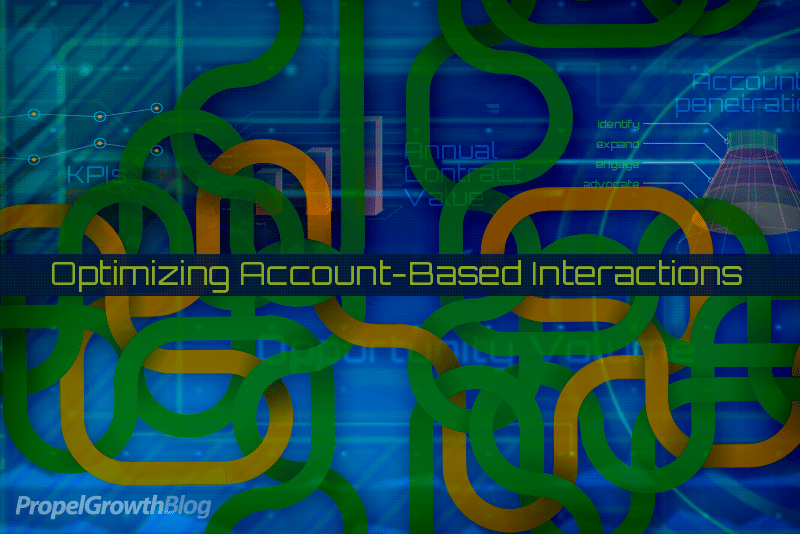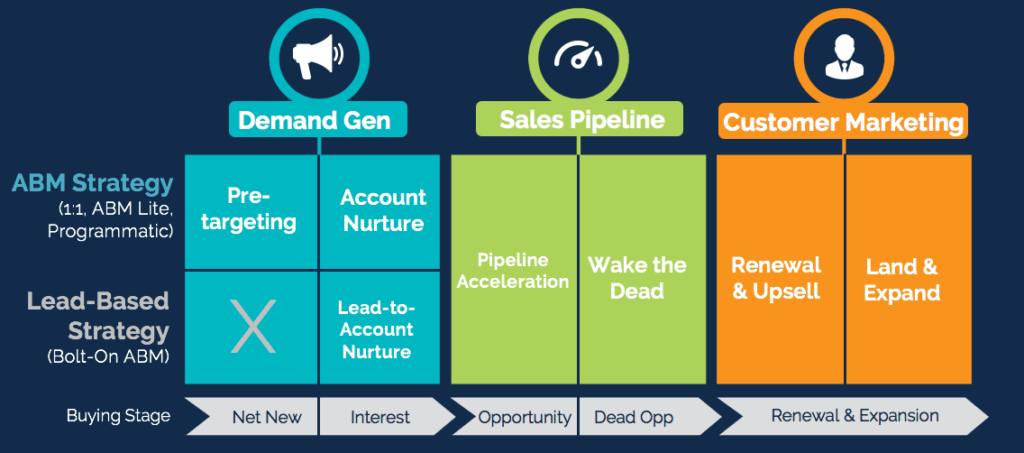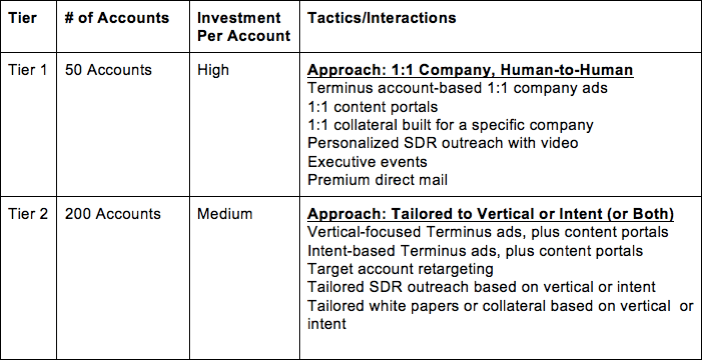
The following is a guest post by Peter Herbert, VP of Marketing at Terminus.
Account-based interactions are the tactics and activities orchestrated to engage a target account.
Orchestrating interactions at an account through multiple digital channels and people in your organization is key to the success of Account Based Marketing (ABM).
After all, you can’t go “account-based” simply by adopting a technology stack, running a campaign, or even changing just your marketing practices. ABM requires a go-to-market team transformation to focus your organization on high-value accounts. It works best when a spectrum of interactions is deployed.
Across our industry, most B2B marketers now understand the benefits of ABM, at least at a high level. According to the #FlipMyFunnel 2017 State of ABM Survey, 81% of B2B Marketers are adopting ABM. But the question remains, “How do marketing and sales teams actually do ABM?”
The answer is orchestrating engagement through account-based interactions, or coordinated promotion and outreach, to your ideal customers.
How much time, energy, and money you spend promoting to these accounts, personalizing content, and orchestrating people talking to people depends on your business objectives as well as how you are prioritizing, or tiering, your accounts.
There are many considerations for your ABM program, but I suggest three major priorities to figure out your plan.
Priority #1: Solve Business Problems
First, your account-based program should be designed to address a business challenge, and your goals around pipeline and revenue will drive your strategy. ABM is so compelling because it helps companies grow more efficiently – not because the tech is sweet!
When I started ABM as a “target account” initiative at a growing software company in 2015, our goal was to grow our average selling price (ASP) and shift from transactional sales to enterprise accounts. We needed to get better at selling larger deals to enterprise IT organizations while keeping an eye on efficiency.
In other words, ideally we would not spend time and money on activities, leads, and prospect accounts that were not a good fit. We wanted to invest less on broad-based marketing that led to distractions for our marketing and sales operations teams, and later to sales development and account executives. We needed to initially focus on pre-targeting and account nurturing to create better sales appointments, and that’s where my team invested first.
To develop a plan to engage your target accounts, you need to know which type of program solves your highest priority business challenges. For example, consider these approaches and plan for the ones that meet your business’s needs:

- Pre-targeting: Generate awareness with cold or net-new accounts to create more sales appointments
- Account/Deal Nurture: Engage key stakeholders within accounts to increase awareness, interest, and conversion to sales pipeline
- Pipeline Acceleration: Engage a wider audience of stakeholders during the sales process to increase pipeline velocity and win rates
- Wake the Dead: Generate pipeline by reengaging cold, stalled, or dead opportunities
- Land & Expand: Engage other divisions or business units within an account
- Renewal & Upsell: Engage key decision-makers beyond the end user in order to increase renewal rates and your average contract value (ACV)
Each of these approaches can include different interactions, and you need to know where you want to focus to pick the right interactions, messages, content, and people you will target.
Priority #2: Know Your Most Valuable Accounts and Get Personal
One key lesson I have learned doing ABM is that you can’t do everything, certainly not at scale. It’s hard enough to think about orchestrating high-quality, relevant, personal interactions at 10 accounts, nevermind at 500 or 3,000. The only way you can scale is to tier your accounts, which is a form of prioritization.
Companies selling to large enterprises may prioritize well-known strategic accounts, for which a long sales cycle is necessary to land a big deal. Other companies may need a more dynamic model to determine which accounts to prioritize, focusing on real-time engagement and intent signals. Either way, adopt a data-driven approach to determining your tiers.
Once you do that, you can focus on investing most of your time, energy, and money for personalizing, promoting, and orchestrating interactions at your highest value accounts and the accounts most likely to buy.
Nobody likes to receive a template email from an SDR anymore, and most importantly, this tactic just isn’t that effective. If I’m your top-tier decision-maker or influencer, I’m more likely to respond if receive a personalized piece of content that’s thoughtful, makes me want to learn more, shows me you did your research, and connects with me on some level.
For example, in a tiered approach to ABM, your top two tiers can look something like this.
One of the hardest steps in an account-based program is developing the appropriate content that is personalized or tailored. It’s pretty easy to just target accounts with generic content, but the results when you add relevancy and personalization are so much more compelling.
The most successful account-based advertising campaign my teams have run have been intent-based: one campaign of 100 unengaged accounts showing intent on a topic resulted in 55% of the accounts clicking through our ads to content portals with curated information on the topic.
Priority #3: Make Engagement Actionable (Stop Running Your Business on Form Fills)
The goal of your account-based interactions must be to create engagement with the people at your target accounts who can influence or decide about buying your product. Too many marketing teams are still relying on not only lead-based goals, but also lead-based triggers for sales development to take action.
Account-based interactions can change your operations in some significant ways:
- Your funnel gets more focused because you aren’t wasting time, energy, and money on efforts that are not of high value to your organization.
- Within this focused funnel, you can trigger your sales development team to act earlier, and with more insight, to reach out to engaged target accounts. Think of how many companies the team would reach out to if they were waiting for forms to be filled out, versus how many companies they would reach out to if you were operationalizing engagement. There’s a big difference and your connection with the account will be earlier, and perhaps at a higher level.
With account-based, you are tracking overall account engagement and web engagement through tools such as Engagio and Terminus. Therefore, many of your tactics will be designed to create engagement rather than to direct high-value people to traditional landing pages with forms.
Your priority should be getting the right people to the most relevant content. I have seen great results through directing advertisements or sales development outreach to customized content portals created for a person, a company, a segment of accounts, or a segment based on intent data.
All these levels of relevancy are more effective than generic landing pages. And because we can use account-based tools to understand which accounts, and even which people at accounts are visiting these assets, we can operationalize our people (sales development) to reach out to the right people at that account.
Your priorities should be creating engagement through account-based interactions and operationalizing engagement as a trigger for outreach. You no longer need to run your business on form fills.
(Inter)Actions Express Priorities
As you plan to launch or optimize your account-based program and interactions, act on three things:
- Define your business problem and create a program that will result in the right kind of impact for your organization, whether that is engaging new accounts, expanding within strategic customer accounts, etc.
- Develop a system of prioritizing accounts through tiers, and invest more in your top tier with more relevant and personalized interactions. Then scale by tapering your investment through your tiers.
- Finally, create tactics and assets that encourage engagement, and do the work to operationalize engagement as your primary trigger for sales to act and get people talking to people.
By shifting to account-based, you can create a more efficient go-to-market effort that delivers revenue for your business.
Scaling Up Sales Growth Using Account-Based Marketing with Jon Miller – Episode 010
![]()







